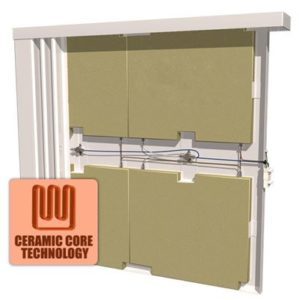A Brief History of German-Made Ceramic Electric Heaters
German-made ceramic electric radiators are testament to the precision engineering and innovation that we’ve come to expect from German manufacturers as a whole. Let’s take a look at where it all started and how they have evolved to become what’s widely regarded as the best direct electric heating technology available today.
What’s the ceramic material inside German electric radiators?
What’s the ceramic material inside German electric radiators?
The ceramic in question is known in Germany as “chamotte”. It’s also known elsewhere as “Fireclay”. Chamotte was first used in domestic heating over 500 years ago in Central Europe. Kachelöfen (tiled stoves) made from chamotte were commonly used for heating and cooking, and later also in industry. The primary function of chamotte in wood and coal-fired Kachelöfen design was to absorb and retain heat whilst withstanding the very high temperatures produced. It reduced the consumption of fuel, whilst providing a sustained and uniform distribution of heat without the need for any maintenance. The use of chamotte continued into electrically-powered heating in the form of electrical tiled stoves in the 1960’s and now to the electric radiators that we know today.
At the heart of every genuine German-built electric radiator is a series of ceramic (chamotte) heat-retaining plates – each with its own heating element tightly imbedded inside.
Though the ceramic material traditionally used in German radiators is certainly quite exceptional at holding heat, there is no magic involved, as some German electric heating suppliers might have you believe. Though a thicker ceramic plate might take longer to cool-down, it must also be considered that consequently, it also takes longer to warm-up. Others might claim to be made from a “magmatic” material (possibly inferring that it’s from a volcano) but again, any claims of magical properties should be discounted. One thing remains true regardless: Where German electric heating is concerned, the heat-retaining ceramic material should be formed from the dense mineral-rich clay known as chamotte.

And the heating elements?
The heating elements contained inside a German Radiator should always be sealed within the ceramic plates. Importantly, the clay should be formed and compressed extremely tightly around the heating elements before it is kiln-fired. This process is key to ensuring longevity and an effective heat-transfer. Heating elements pushed into holes drilled into the ceramic plates after firing lose both the reliability and effectiveness of those that are correctly sealed inside. Any contact with air inside the radiator body can reduce the transfer of heat to the ceramic, cause burning of dust particles, have a drying-effect on the air in the room, and ultimately cause heating elements to fail prematurely. Advancements in design have further increased reliability with the use of high-quality thermal switches and re-shaped ceramic plates, designed to create cooler operating temperatures for the associated electronic components inside the body of the radiator.
The steel outer body
Though most German electric radiators have a very similar appearance, higher-quality products are generally manufactured from a higher grade rolled steel, with the best manufactures even opting for zinc-galvanised steel for a truly robust build. A fluted outer casing is spot-welded across many points of the radiator to promote a healthy combination of both radiant and convectional heat output.
As environmental concern continues to be at the forefront of our consciousness, German-made electric radiators have embraced the challenge of sustainability and energy efficiency. Manufacturers continue to optimise heat distribution and also integrate smart controls to minimize energy consumption without compromising comfort.
Innovative Design and Functionality: German engineering is synonymous with precision and attention to detail, and ceramic electric heaters are no exception. Design aesthetics evolved alongside technological advancements, with sleek and modern designs complementing the functionality of these heaters. Features such as programmable thermostats, remote control operation, and silent operation became standard, offering users unparalleled convenience and comfort.
Looking Ahead
As we look to the future, German-made ceramic electric radiators are most certainly here to stay. Advances in digital connectivity and energy management are certain to further enhance the performance and efficiency. With a well-established commitment to quality and sustainability, German manufacturers remain at the forefront of heating technology.




